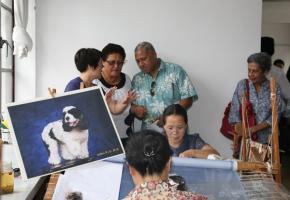Eight Cuisines of China
Chinese cookery methods formed a history of over 3,000 years ago. Yi Yin, a prime minister of the Shang Dynasty, was the forefather of Chinese culinary art. He wrote "On Original Tastes," for hist profound understanding of cooking techniques in ancient china. The book covers detailed, pertinent description of such cooking matters as ingredients, species, heat nourishment and hygiene.
The vastness of China's geography and history echoes through the polyphony of Chinese cuisine. Chinese cookery developed and matured over the centuries and entered its heyday in the Qing dynasty (1644 -1911). Qing cuisine is characterized by its large scale and meticulous cooking techniques. Most famous are the Qing and Han Royal Feast, Thousand-Elderly Banquet and Confucius Mansion Banquet.
Now, a variety of cuisines have formed out of different local products, climates, traditions and eating habits. Chinese food and drinks are featured by local cuisines. Each local cuisine has its own characteristics. To begin, it is best to divide Chinese cuisine, with all the appropriate disclaimers and caveats, into that of four major regions: the northern plains, the fertile east, watered by the Yangtze River; the south, famous for the Cantonese cooking of the Guangdong Province; and the fecund west of Szechwan and Hunan Provinces. Thus Chinese cuisine as a whole is divided into four major schools - Shandong, Sichuan, Huaiyang and Guangdong. These can be expanded into eight - Shandong, Sichuan, Yangzhou, Guangdong, Hunan, Fujian, Anhui, and Zhejiang. Sometime Beijing and Shanghai cuisines are added.
* Shandong Cuisine
This is the local flavor of Jinan City and Jiaodong peninsula derived from the use of shallots and garlic. Both restaurant chefs and those in families are expert in cooking Braised Abaloneseafood, soups, meat and offal. The recipes are those that once delighted the royal court and were served to the emperor.
The typical menu can include many delicate dishes such as:
Braised abalone - smooth, delicate, fresh and savory
Sweet and Sour Carp - with crisp exterior and tender fish interior, a little sweet and sour
Bree with a complex - clear, mild and fresh
'Eight Immortals Crossing Sea teasing Arhats' - This is a starter before a celebration feast. It is luxurious and traditionally uses as its eight main ingredients: fin, sea pumpkin, abalone, asparagus, prawns and ham. The stock is flavored with fish's swimming bladder and fish bones. These symbolize the eight immortals and the Arhats [Buddhist saints] are symbolized by the inclusion of chicken breast.
* Guangdong Cuisine
Cantonese is southern Chinese cooking - lots of steaming, boiling and stir-frying. Canton is, perhaps, the most famous of the food areas. It's the best of the bunch if you're worried about cholesterol and coronaries, as it uses the least amount of oil. It's lightly cooked and not as highly spiced as the other three. Long, warm, wet days throughout the year create the perfect environment for cultivating most everything. The coast provides ample seafood; the groves are filled with fruits. Lots of seafood, vegetables, roast pork, chicken, steamed fish and fried rice.
Chrysanthemum fish - chefs with adept cutting techniques shape the fish like chrysanthemums, each individual morsel being convenient to enjoy with either chopsticks or forks.
Braised Snake porridge - choose rare meat of cobra, grimalkin, and pullet, braised elaborately, also called 'Dragon and phoenix contending' (Long Feng Dou).
Roast suckling pig - a famed dish with rather long history, golden and crisp exterior, and tender meat, with dense aroma.
* Sichuan Cuisine
Sichuan is the hottest of the four categories and is characterized by heavy use of spices and peppers. Specialties include frogs' legs and smoked duck; the duck is cooked in peppercorns, marinated in wine for 24 hours, covered in tea leaves and cooked over a charcoal fire. Other dishes to try are shrimps with salt and garlic; dried chilli beef; vegetables and bean curd; bears' paws braised in brown sauce; fish in spicy bean sauce and aubergines in garlic.
Delicious dishes menu:
Stir-fried Tofu with Minced Beef in Spicy Bean Sauce - A real feast of tender bean curd, minced beef, pepper and bean sauce. It is said that it was made by a pock-marked but ingenious woman, thus the name Ma Po Tofu (pock-marked woman's bean curd).
Twice-cooked PorkLamp-shadow Beef - with larruping techniques, the beef is cut in very thin sheet. When a piece is carried, it looks like translucent paper, slippery and reddish. When put under the lamp or light, a red shadow will appear.
Lung Pieces by Couple - a quite popular in Chengdu. It got the name because the dish was ever sold be a couple and today it remains the original savor, tender meat, tingling and spicy.
Gong Bao Ji Ding - in Chinese it is called Gong Bao Ji Ding. This is a tender chicken dish, tender as the meat is quickly fried. Flavored with peanuts, this is tasty and very popular.
* Hunan Cuisine
Fish Head with Chopped ChiliHunan cuisine lays a stress on the use of oil, dense color, and techniques that produce crispness, softness and tenderness as well as the savory flavors and spices. Stewed fins, fried fresh cabbage with chestnuts, Dong Anzi chicken, immortal chicken with five elements, are of the highest reputation. Chairman Mao, together with other leaders praised the Hunan cuisine in 1958.
Stewed fins - had been famous during the Qing Dynasty. Choice fins, chickens, pork are stewed in chicken soup and sauce, tasting really fresh and mellow.
Immortal chicken with five elements - means to put five elements, litchi, longan, red dates, lotus seeds, and medlar, into the body of a chicken, then to braise. The taste is rather peculiar but it is said to have the effect of strengthening the constitution.
* Jiangsu Cuisine
Eight Delicacies Chili Sauce, Shanghai CuisineJiangsu Cuisine developed from the local recipes of Yangzhou, Suzhou and Nanjing. Its main cooking techniques are braising and stewing, thereby enhancing the original flavor and sauce. The elegant color, novel sculpts, with salt and sweet taste will soothe your stomach. The Jiangsu cuisine has several branches, including Shanghai cuisine, Nanjing cuisine is known for its duck recipes, Suxi cuisine with flowery hue, etc. the most highly recommended courses are:
Three sets of ducks - an interlinking dish, that is to put pigeon into wild duck, then put the wild duck into a fowl duck. When stewed, the fowl duck is tender, the wild one crisp, and the little pigeon delicate!
Pan-Fried BunsBoiled dry thread of Tofu - thanks to the exquisite skill of the chefs, the Tofu can be cut into very thin threads which have chances to absorb the savor of soup. When chicken pieces added to the soup, the dish is called 'chicken dry thread'; likewise, when shrimp added, it makes 'shrimp dry thread'.
Lion's head braised with crab-powder - there is a metaphor in the dish name. In actual fact the Lion's head is a conglomeration of meat that is shaped like a sunflower and resembles a lion's head. It can be braised in a clear soup, or be red-cooked in a dense soup. A seasoning of crab powder enhances the flavor.
* Zhejiang Cuisine
Stir-fried Beef Fillet with Hot Green PepperAs Zhejiang cuisine consists of hundreds of small delicacies from its main cities, it takes in Hangzhou's fineness and diversification, Ningbo's softness and originality, and Shaoxing's pastoral interests. Hangzhou, once the capital of the Southern Song Dynasty (1127 - 1279), it is customary to endow cuisine with dainty place-names. The chief techniques of cooking lie in the methods used such as frying, quick-fry, stir-fry, braising, and steaming thus rendering the dishes both salubrious and savory.
West-lake braised fish in vinegar - is a traditional delicacy in Hangzhou. It is said that there was once a boy who made his living by fishing. When he fell ill, his sister-in-law fished for him and braised the fish she caught with a marinade of vinegar and sugar. He was said to have made an immediate recovery after eating it. The boy's story aroused the attention of the emperor and the recipe has been used ever since.
Shelled shrimps cooked in Longjing tea - as the Longjing tea is taken from the best tea in Hangzhou, which is recognized for greenness, fragrance, pure taste and elegant looks, when the living shrimps are stir-fried in the Long tea, the dish sends an artistic aroma and is quite delicious.
* Fujian Cuisine
Fujian cuisine has four distinctive features, that is, fine cutting techniques, alternative soups, unique seasonings, and exquisite cooking. Chefs can always cut the thin jellyfish into three pieces and into very thin thread. And thanks to the abundant resources of marine products, the soup of this cuisine genre has its freshness and keeps its own savor with ease. The seasonings add sweet and sour flavors to the dishes. To add to its appeal the food is served in or on elegant bowls or plates.
Appealing dishes are countless, so we can only exemplify some of them:
Fried golden bamboo shoot with chicken mince - every 100g of winter bamboo shoots will be cut into 500 - 600 strips with the same length and breadth. Then they can blend with the very small pieces of chicken.
Buddha jumping over the wall - the most famous and classical dish, which has a long history since the Qing Dynasty.
Dongbi dragon pearl - it chooses materials from the rare longan trees of thousand year's history in Kaiyuan Temple in Quanzhou, the delicate scent is rather catching.
'Fried Xi Shi's tongue'is made from the locally produced Fujian mussel. According to legend the concubine Xi Shi of the king of Wu state was thrown in the sea tied to a huge stone by the wife of Gou Jian, the king of Yue who destroyed Wu, to prevent her husband being seduced by her beauty. In the area of the sea where she sank, a special breed of mussel appeared and this was said to be Xi Shi's tongue.
* Anhui Cuisine
Bamboo Shoots with Chicken SoupIt is mainly composed of local flavors of Huizhou and other areas along the Yangtze River and the Huai River. Among the dishes on the Ahhui cuisine menu, you will find less fried or quick-fried dishes than those that are braised. People here are inclined to add ham as seasoning and sugar candy to enrich the freshness and are quite accomplished in the art of cooking.
Among these delicacies, some of the traditional ones are outstanding:
'Braised turtle with ham' - the oldest dish using the special 'Mati turtle'. The delightful taste of this dish has inspired poets.
'Fuliji Grilled chicken' - the cooking technique was derived from Dezhou braised chicken of Shandong Province, with improvement of the technique by the Fuliji chef. The grilled chicken is golden and tempting, and the meat is so well cooked that it falls easily from the bone.
* Other Cuisines
Beijing Cuisine
Beijing food comes from one of the coldest parts of China and uses heaps of spices and chilli to warm the body up. Bread and noodles are often used instead of rice. Beijing is capital of the country. As it is a cultural melting pot, traces of Muslim, Mongolian and Manchurian influences can be seen, and indeed it was the Manchu Dynasty which instituted the tradition of Imperial food, with its famous three-day feasts. Peking food is elegant and exotic, with subtle, delicate seasonings and is often barbecued, deep-fried or cooked in chafing dishes. The chief specialty is Beijing Duck, eaten with pancake and plum sauce. Another chicken specialty is Veggar's Chicken, supposedly created by a beggar who stole the emperor's chicken and then had to bury it in the ground to cook it - the dish is wrapped in lotus leaves and baked all day in hot ashes.
Some good Beijing dishes: chicken or pork with soya-bean sauce; bean curd with pepper sauce; fried shredded beef with chilli sauce; stewed mixed vegetables; barbecued chicken; fried shrimp eggs and pork pancakes. Another speciality is Mongolian barbecue - assorted barbe3cued meats and vegetables mixed in a hotpot. Birds' nest soup is a speciality of Shandong cooking, as is sweet and sour Yellow River carp. The latter is served singed on the outside but tender inside.
Shanghia Cuisine
Shanghainese and Jiangzhenese, referred as Huaiyang in the past, food is noted for its use of seafoods. It's heavier and oilier than either Beijing or Cantonese, and uses lots of chilli and spices. Eels are also popular and so is drunken chicken - the bird cooked in shaoshing a potent Chinese wine which tastes a bit like warm sherry. Other things to try are Tientsin cabbage, some of the cold meat and sauce dishes, ham and melon soup, bean curd and brown sauce, braised meat balls, deep-fried chicken, and pork rib with salt and pepper. Jiangzhe cooking specializes in poultry and seafood, and the dishes are cooked in their own juices to preserve their original flavor.

 Accessible China Tours
Accessible China Tours First-Time China Tours
First-Time China Tours China Hiking & Trekking Tours
China Hiking & Trekking Tours 

